Related Research Articles

John Wood Campbell Jr. was an American science fiction writer and editor. He was editor of Astounding Science Fiction from late 1937 until his death and was part of the Golden Age of Science Fiction. Campbell wrote super-science space opera under his own name and stories under his primary pseudonym, Don A. Stuart. Campbell also used the pen names Karl Van Kampen and Arthur McCann. His novella Who Goes There? was adapted as the films The Thing from Another World (1951), The Thing (1982), and The Thing (2011).
The Galactic Empire series is a science fiction sequence of three of Isaac Asimov's earliest novels, and extended by one short story. They are connected by their early place in his published works and chronological placement within his overarching Foundation universe, set around the rise of Asimov's Galactic Empire, between the Robot and Foundation series to which they were linked in Asimov's later novels.
"Blind Alley" is a science fiction short story by American writer Isaac Asimov. It was first published in the March 1945 issue of Astounding Science Fiction, and later included in the collection The Early Asimov (1972).
"Robbie" is a science fiction short story by American writer Isaac Asimov. It was the first of Asimov's positronic robot stories. In 2016, "'Robbie" won a retrospective 1941 Hugo Award for best short story. "Robbie" was the fourteenth story written by Asimov, and the ninth to be published. It was the first story in Asimov's Robot series.
The Golden Age of Science Fiction, often identified in the United States as the years 1938–1946, was a period in which a number of foundational works of science fiction literature appeared. In the history of science fiction, the Golden Age follows the "pulp era" of the 1920s and 1930s, and precedes New Wave science fiction of the 1960s and 1970s. The 1950s are, in this scheme, a transitional period. Robert Silverberg, who came of age in the 1950s, saw that decade as the true Golden Age. According to historian Adam Roberts, "the phrase Golden Age valorises a particular sort of writing: 'Hard SF', linear narratives, heroes solving problems or countering threats in a space-opera or technological-adventure idiom."
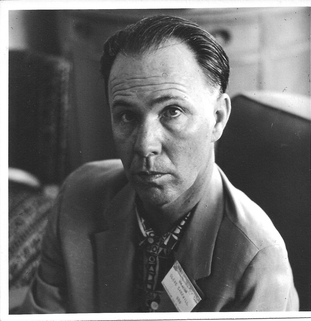
Cleve Cartmill was an American writer of science fiction and fantasy short stories. He is best remembered for what is sometimes referred to as "the Cleve Cartmill affair", when his 1944 story "Deadline" attracted the attention of the FBI by reason of its detailed description of a nuclear weapon similar to that being developed by the highly classified Manhattan Project.
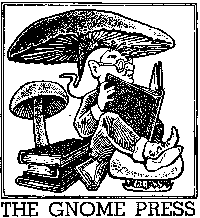
Gnome Press was an American small-press publishing company primarily known for publishing many science fiction classics. Gnome was one of the most eminent of the fan publishers of SF, producing 86 titles in its lifespan — many considered classic works of SF and Fantasy today. Gnome was important in the transitional period between Genre SF as a magazine phenomenon and its arrival in mass-market book publishing, but proved too underfunded to make the leap from fan-based publishing to the professional level. The company existed for just over a decade, ultimately failing due to inability to compete with major publishers who also started to publish science fiction. In its heyday, Gnome published many of the major SF authors, and in some cases, as with Robert E. Howard's Conan series and Isaac Asimov's Foundation series, was responsible for the manner in which their stories were collected into book form.

Miles John Breuer was an American physician and science fiction writer of Czech origin. Although he had published elsewhere since the early 20th century, he is considered the part of the first generation of writers to appear regularly in the pulp science fiction magazines, publishing his first story, "The Man with the Strange Head", in the January 1927 issue of Amazing Stories. His best known works are "The Gostak and the Doshes" (1930) and two stories written jointly with Jack Williamson, "The Girl from Mars" (1929) and The Birth of a New Republic (1931).
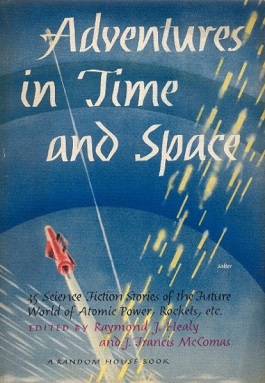
Adventures in Time and Space is an American anthology of science fiction stories edited by Raymond J. Healy and J. Francis McComas and published in 1946 by Random House. A second edition was also published in 1946 that eliminated the last five stories. A Modern Library edition was issued in 1957. When it was re-released in 1975 by Ballantine Books, Analog book reviewer Lester del Rey referred to it as a book he often gave to people in order to turn them onto the genre. It is now once again out of print.
Science in science fiction is the study or of how science is portrayed in works of science fiction, including novels, stories, and films. It covers a large range of topics, since science takes on many roles in science fiction. Hard science fiction is based on engineering or the "hard" sciences, whereas soft science fiction is based on the "soft" sciences, and especially the social sciences.

Journey to Infinity is a 1951 anthology of science fiction short stories edited by Martin Greenberg. The stories originally appeared in the magazines Astounding SF, Amazing Stories and Future Science Fiction.

The Moon Is Hell! is a collection of two stories, one science fiction, the other sword and sorcery, by American writer John W. Campbell Jr. It was published in 1951 by Fantasy Press in an edition of 4,206 copies. The title story, published for the first time in this collection, deals with a team of scientists stranded on the Moon when their spacecraft crashes, and how they use their combined skills and knowledge to survive until rescue, including building shelter from meteor showers, and creating their own oxygen from Lunar rock. The second story, "The Elder Gods", Campbell rewrote, on a short deadline, from a story by Arthur J. Burks purchased for Unknown but later deemed unsatisfactory. It originally appeared in the October 1939 issue of Unknown under the pseudonym Don A. Stuart. The title of the eponymous story is occasionally found without the exclamation point, but the punctuation is used for the title of most editions of the collection itself.
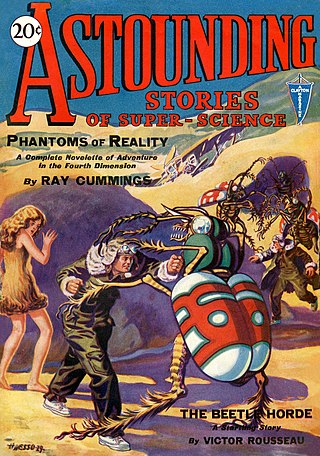
Analog Science Fiction and Fact is an American science fiction magazine published under various titles since 1930. Originally titled Astounding Stories of Super-Science, the first issue was dated January 1930, published by William Clayton, and edited by Harry Bates. Clayton went bankrupt in 1933 and the magazine was sold to Street & Smith. The new editor was F. Orlin Tremaine, who soon made Astounding the leading magazine in the nascent pulp science fiction field, publishing well-regarded stories such as Jack Williamson's Legion of Space and John W. Campbell's "Twilight". At the end of 1937, Campbell took over editorial duties under Tremaine's supervision, and the following year Tremaine was let go, giving Campbell more independence. Over the next few years Campbell published many stories that became classics in the field, including Isaac Asimov's Foundation series, A. E. van Vogt's Slan, and several novels and stories by Robert A. Heinlein. The period beginning with Campbell's editorship is often referred to as the Golden Age of Science Fiction.
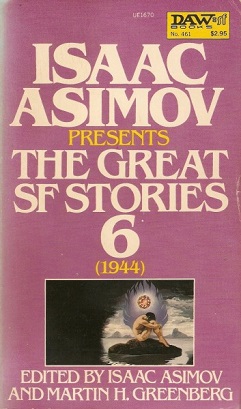
Isaac Asimov Presents The Great SF Stories 6 (1944) is the sixth volume of Isaac Asimov Presents The Great SF Stories, which is a series of short story collections, edited by Isaac Asimov and Martin H. Greenberg, which attempts to list the great science fiction stories from the Golden Age of Science Fiction. They date the Golden Age as beginning in 1939 and lasting until 1963. The book was later reprinted as the second half of Isaac Asimov Presents The Golden Years of Science Fiction, Third Series with the first half being Isaac Asimov Presents The Great SF Stories 5 (1943). This volume was originally published by DAW books in December 1981.
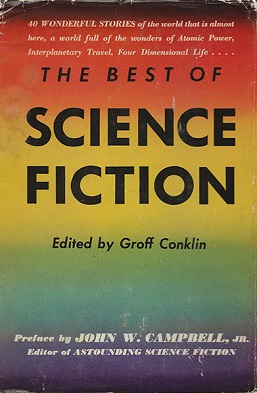
The Best of Science Fiction, published in 1946, is an anthology of science fiction anthologies edited by American critic and editor Groff Conklin.

Science-Fiction Adventures in Dimension is an anthology of science fiction stories edited by Groff Conklin, first published by Vanguard Press in hardcover in 1953. An abridged edition was issued by Grayson & Grayson in the UK, and an abridged paperback edition, with a different selection of stories from the original, was issued by Berkley Books; both abridgments carried unhyphenated titles.

The Astounding, the Amazing, and the Unknown is an alternate historical adventure novel written by Paul Malmont, the sequel to The Chinatown Death Cloud Peril (2007). It features real-life pulp magazine authors of the past as the heroes of adventures reminiscent of their favored genres. The book was first published in hardcover by Simon & Schuster and audiobook by Brilliance Audio in July 2011. The title is drawn from those of the magazines, Astounding Science-Fiction, Amazing Stories, and Unknown, for which his main protagonists wrote.

A Treasury of Science Fiction is an American anthology of science fiction short stories edited by Groff Conklin. It was first published in hardcover by Crown Publishers in 1948, and reprinted in March 1951. A later edition was issued by Bonanza Books/Crown Publishers in March 1980. An abridged paperback version including eight of its thirty stories was published by Berkley Books in July 1957 and reprinted in January 1958 and January 1965.

Fifty Short Science Fiction Tales is an anthology of science fiction short stories and poems edited by Isaac Asimov and Groff Conklin. It was first published in paperback by Collier Books in 1963 and reprinted in 1966, 1968, 1969, 1971, 1973, 1974, 1976, and 1978; a later reprint was issued by Scribner Paperback Fiction in August 1997. The book has been translated into Italian.
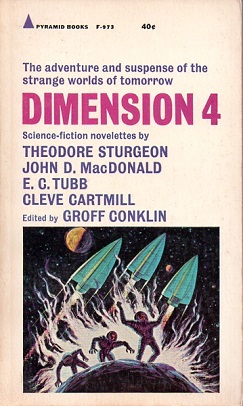
Dimension 4 is an anthology of science fiction short stories edited by Groff Conklin. It was first published in paperback by Pyramid Books in February 1964.
References
- ↑ Cartmill, Cleve, "Deadline". Astounding Science Fiction, Vol. XXXIII, No. l, pp. 154-178. New York: Street & Smith, March 1944
- ↑ Silverberg, Robert, Reflections: The Cleve Cartmill Affair: One Archived 2013-06-18 at the Wayback Machine , Asimov's Science Fiction
- ↑ Silverberg, Robert, Reflections: The Cleve Cartmill Affair: Two Archived 2014-10-06 at the Wayback Machine , Asimov's Science Fiction
- ↑ Rogers, Alva (1964). A Requiem for Astounding . Advent. ISBN 0-911682-16-3.
- ↑ See "Deadline" title listing at the Internet Speculative Fiction Database